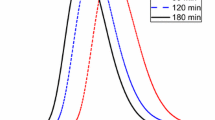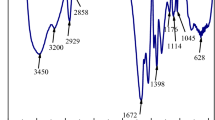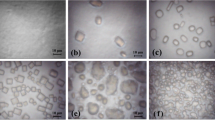Abstract
Preparation of associating multiblock copolymer electrolytes mediated by radical addition–fragmentation chain transfer (RAFT) technique has been evaluated and reported in this investigation. The synthesization of copolymers was performed at room temperature in 1,4-dioxane using redox catalyst: tert-butyl hydroperoxide and ascorbic acid as initiator. The copolymers are composed of a large hydrophilic block formed with acrylic acid and ethyl acrylate and a short hydrophobic segment of lauryl acrylate. A symmetrical RAFT chain transfer agent was used in order to incorporate a greater number of blocks by chain extension of macroagent, triblock and pentablock copolymers. Once obtained, the resultant polymers were thoroughly characterized by nuclear magnetic resonance, size exclusion chromatography, differential scanning calorimetry and rheometry with the aim to determine the structure–property relationship. The influence of hydrophobic length was demonstrated and played a significant role in the rheological properties of copolymers.







Similar content being viewed by others
References
Llamas S, Guzmán E, Ortega F, Baghdadli N, Cazeneuve C, Rubio RG, Luengo GS (2015) Adsorption of polyelectrolytes and polyelectrolytes-surfactant mixtures at surfaces: a physico-chemical approach to a cosmetic challenge. Adv Colloid Interface Sci 222:461–487
Sabhapondit A, Borthakur A, Haque I (2003) Water soluble acrylamidomethyl propane sulfonate (AMPS) copolymer as an enhanced oil recovery chemical. Energy Fuels 17:683–688
Ghimici L (2016) Cationic polyelectrolyte induced separation of some inorganic contaminants and their mixture (zirconium silicate, kaolin, K-feldspar, zinc oxide) as well as of the paraffin oil from water. J Environ Manag 169:1–7
Saindane P, Jagtap RN (2015) RAFT copolymerization of amphiphilic poly (ethyl acrylate-b-acrylic acid) as wetting and dispersing agents for water borne coating. Prog Org Coat 79:106–114
Rolland J, Poggi E, Vlad A, Gohy J-F (2015) Single-ion diblock copolymers for solid-state polymer electrolytes. Polymer 68:344–352
Phan TNT, Ferrand A, Ho HT, Liénafa L, Rollet M, Maria S, Boucher R, Gigmes D (2016) Vinyl monomers bearing a sulfonyl(trifluoromethane sulfonyl) imide group: synthesis and polymerization using nitroxide-mediated polymerization. Polym Chem 7:6901–6910
Volpert E, Selb J, Candau F (1996) Influence of the hydrophobe structure on composition, microstructure, and rheology in associating polyacrylamides prepared by micellar copolymerization. Macromolecules 29(5):1452–1463
Jiménez-Regalado EJ, Selb J, Cadau F (1999) Viscoelastic behavior of semidilute solutions of multisticker polymer chains. Macromolecules 32:8580–8588
Jiménez-Regalado EJ, Cadenas-Pliego G, Pérez-Álvarez M, Hernández-Valdez Y (2004) Characterization and rheological properties of dilute-solutions of three different families of water-soluble copolymers prepared by solution polymerization. Macromol Res 12(5):451–458
Winnik MA, Yekta A (1997) Associative polymers in aqueous solution. Curr Opin Colloid Interface Sci 2(4):424–436
González-Coronel VJ, Jiménez-Regalado E (2009) Synthesis, characterization and rheological properties of three different microstructures of water-soluble polymers prepared by solution polymerization. J Polym Bull 62(6):727–736
Barrat JL, Joanny JF (1996) Theory of polyelectroyte solutions. Wiley, New York
Schanze KS, Shelton AH (2009) Functional polyelectrolytes. Langmuir 25(24):13698–13702
Alami E, Almgren M, Brown W, François J (1996) Aggregation of Hydrophobically end-capped poly(ethylene oxide) in aqueous solutions. Fluorescence and light-scattering studies. Macromolecules 29:2229–2243
Maechling-Strasser C, Clouet F, François J (1992) Hydrophobically end-capped polyethylene-oxide urethanes: 2. Modelling their association in water. Polymer 33:1021–1025
Lara-Ceniceros AC, Rivera-Vallejo C, Jiménez-Regalado E (2007) Synthesis, characterization and rheological properties of three different associative polymers obtained by micellar polymerization. Polym Bull 58:425–433
Zhu Y, Lowe AB, Roth PJ (2014) Postpolymerization synthesis of (bis)amide (co)polymers: thermoresponsive behavior and self-association. Polymer 55:4425–4431
Díaz-Silvestre SE, St Thomas C, Maldonado-Textle H, Rivera-Vallejo C, Díaz de León-Gómez RE, Jiménez-Regalado EJ (2018) Effect of N-isopropylacrylamide thermoresponsive blocks on the rheological properties of water-soluble thermoassociative copolymers synthesized via RAFT polymerization. Colloid Polym Sci 296:1699–1710
Chen H-X, Tang H-M, Wu X-Y, Liu Y-G, Bai J-H, Zhao F (2016) Synthesis, characterization, and property evaluation of a hydrophobically modified polyacrylamide as enhanced oil recovery chemical. J Disper Sci Technol 37:486–495
Kostansek E (2005) Associative polymer/latex dispersion phase diagrams II: HASE thickeners. J Coat Technol Res 2:417–422
Eisenberg A, Kim J-S (1998) Introduction to ionomers. Wiley, New York
Budd PM (1989) Comprehensive polymer science and supplements, Chap 11. Polyelectrolytes 1:215–230
Alb AM, Paril A, Çatalgil-Giz H, Giz A, Reed WF (2007) Evolution of composition, molar mass, and conductivity during the free radical copolymerization of polyelectrolytes. J Phys Chem B 111:8560–8566
Jenkins AD, Jones RG, Moad G (2010) Terminology for reversible-deactivation radical polymerization previously called “controlled” radical or “living” radical polymerization (IUPAC Recommendations 2010). Pure Appl Chem 82(2):483–491
Matyjaszewski K (2017) Kinetics of atom transfer radical polymerization. Eur Polym J 89:482–523
Perrier S (2017) 50th anniversary perspective: RAFT polymerization—a user guide. Macromolecules 50(19):7433–7447
Moad G, Rizzardo E, Thang SH (2012) Living radical polymerization by the RAFT process—a third update. Aust J Chem 65:985–1076
Chiefari J, Chong YK, Ercole F, Krstina J, Jeffery J, Le TPT, Mayadunne RTA, Meijs GF, Moad CL, Moad G, Rizzardo E, Thang SH (1998) Living free-radical polymerization by reversible addition-fragmentation chain transfer: the RAFT process. Macromolecules 31:5559–5562
Pearson S, St Thomas C, Guerrero Santos R, D’Agosto F (2017) Opportunities for dual RDRP agents in synthesizing novel polymeric materials. Polym Chem 8:4916–4946
Guzmán G, Nava D, Vazquez-Arenas J, Cardoso J, Alvarez-Ramirez J (2018) Polymer electrolytes through functionalization of poly (poly (ethylene glycol) methacrylate) with zwitterionic pendant groups: the role of ion clusters upon conductivity. Solid State Ionic 320:45–54
Chaduc I, Crepet A, Boyron O, Charleux B, D’Agosto F, Lansalot M (2013) Effect of the pH on the RAFT polymerization of acrylic acid in water. Application to the synthesis of poly(acrylic acid)-stabilized polystyrene particles by RAFT emulsion polymerization. Macromolecules 46:6013–6023
Yu Q, Wu X, Li Y, Gao T, Liu S, Hou C, Zheng Z (2018) Synthesis, characterization, and aqueous properties of an amphiphilic terpolymer with a novel nonionic surfmer. Int J Polym Sci. Article ID 9231837
Bray C, Peltier R, Kim H, Mastrangleo A, Perrier S (2017) Anionic multiblock core cross-linked star copolymers via RAFT polymerization. Polym Chem 8:5513–5524
Martin L, Gody G, Perrier S (2015) Preparation of complex multiblock copolymers via aqueous RAFT polymerization at room temperature. Polym Chem 6:4875–4886
Gody G, Maschmeyer T, Zetterlund P-B, Perrier S (2014) Pushing the limit of the RAFT process: multiblock copolymers by one-pot rapid multiple chain extensions at full monomer conversion. Macromolecules 47:3451–3460
Díaz-Silvestre S, Saldívar-Guerra E, Rivera-Vallejo C, St Thomas C, Cabello-Romero J, Guerrero-Santos R, Jiménez-Regaldo E (2018) Synthesis of associative block copolymers electrolytes via RAFT polymerization. Polym Bull 75(3):891–907
Lai JT, Filla D, Shea R (2002) Functional polymers from novel carboxyl-terminated trithiocarbonates as highly efficient RAFT agents. Macromolecules 35:6754–6756
Chaduc I, Lansalot M, D’Agosto F, Charleux B (2012) RAFT polymerization of methacrylic acid in water. Macromolecules 45:1241–1247
Abel AB, McCormick CL (2016) Mechanistic insights into temperature-dependent trithiocarbonate chain-end degradation during the RAFT polymerization of N-arylmethacrylamides. Macromolecules 49:465–474
López-Pérez L, Maldonado-Textle H, Elizalde-Herrera LE, Telles-Padilla JG, Guerrero-Santos R, Collins S, Jiménez-Reglado EJ, St Thomas C (2019) Methylation of poly(acrylic acid), prepared using RAFT polymerization, with trimethylsilyldiazomethane: a metamorphosis of the thiocarbonyl group to a thiol-end group. Polymer 168:116–125
Graessley WW (1980) Polymer chain dimensions and the dependence of viscoelastic properties on concentration, molecular weight and solvent power. Polymer 21:258–262
Acknowledgements
Authors acknowledge the CONACYT for financial support through the project number 255052 and 267962, respectively. Authors also thank M.C. Ricardo Mendoza-Carrizales and M.C. Maria Guadalupe Mendez-Padilla for SEC and DSC characterizations. CST thanks the CONACYT for his nomination as research fellow at CIQA.
Author information
Authors and Affiliations
Corresponding authors
Ethics declarations
Conflict of interest
Authors declare not competing financial interest.
Additional information
Publisher's Note
Springer Nature remains neutral with regard to jurisdictional claims in published maps and institutional affiliations.
Rights and permissions
About this article
Cite this article
Muñoz-López, C.N., Díaz-Silvestre, S., Telles-Padilla, J.G. et al. Synthesis, characterization and rheological properties of multiblock associative copolymers by RAFT technique. Polym. Bull. 77, 2539–2555 (2020). https://doi.org/10.1007/s00289-019-02867-z
Received:
Revised:
Accepted:
Published:
Issue Date:
DOI: https://doi.org/10.1007/s00289-019-02867-z




